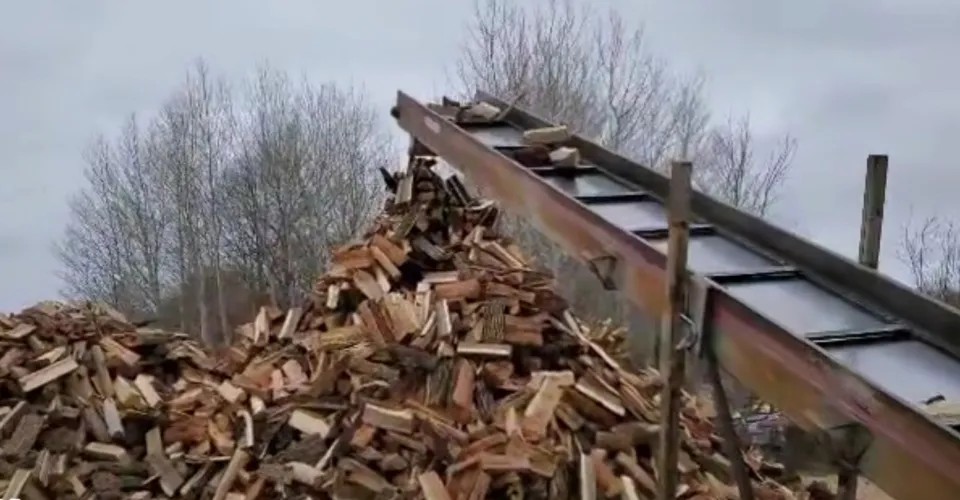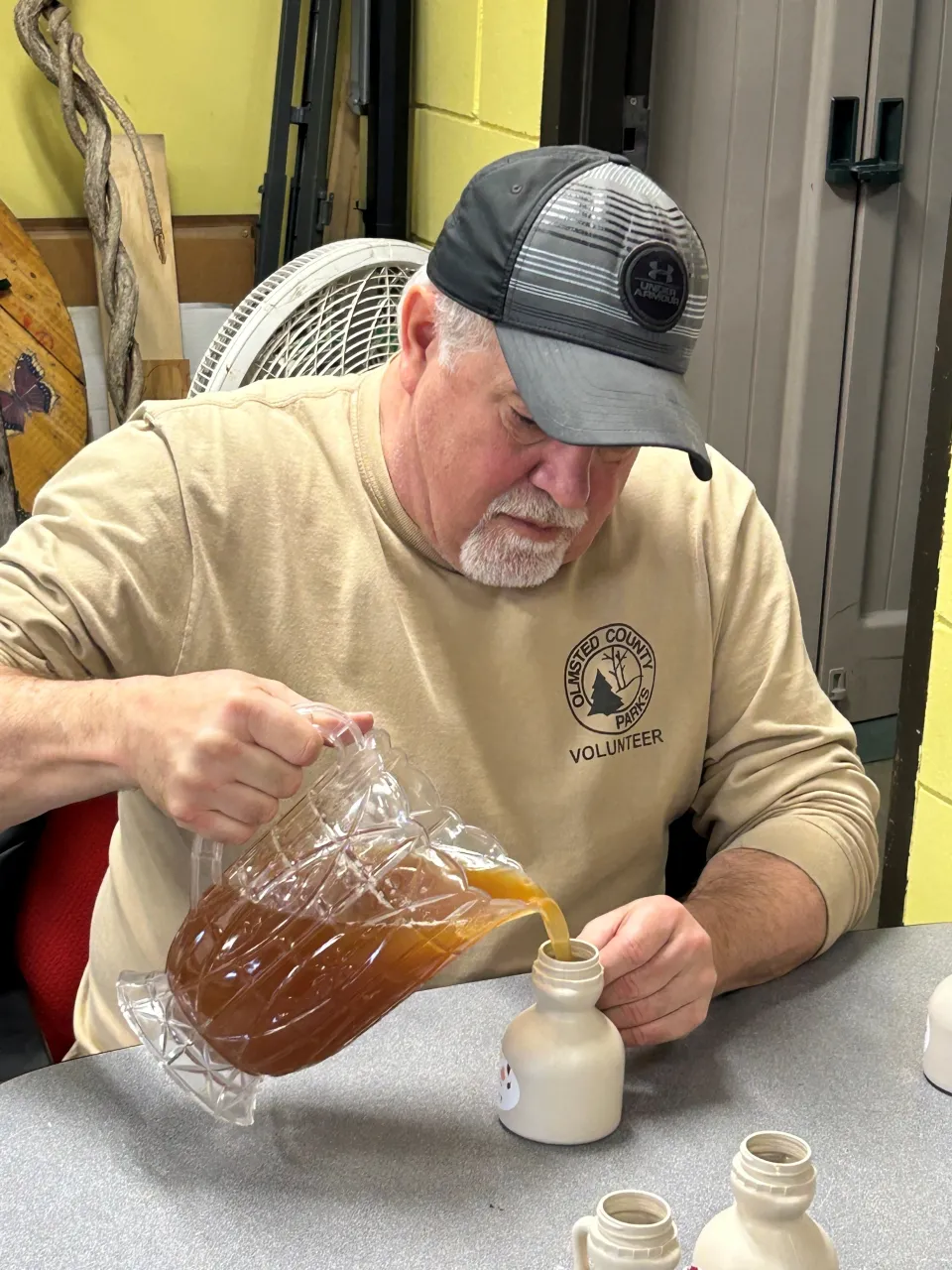Olmsted County Parks Newsletter - Summer 2023
Volume 9, Issue 2
In this Issue:
Maple Syrup Harvesting, Bluebird Boxes, Volunteer Week, Bringing in the Trees, and more...
Bringing in the Trees!
by: Celeste Lewis
Olmsted County Park staff and volunteers have been busy continuing with the tree work that is being done in the campground at Chester Woods Park. As written in the previous newsletter, many black walnut and ash trees were removed from the campground which was just the beginning of the work.
This winter staff, STS (sentence to serve), and volunteers started cutting a splitting some of the downed trees to use as firewood in the campground. Once the snow piled up too high that came to a bit of a halt.
A contractor and log processor were then brought in once the snow melted and in about 3-days’ time, they managed to split approximately 80 cord of wood! (This of course saved staff a TON of time and money!) The park should have approximately two years’ worth of firewood stacked now.
In mid-April the park spaded 12 red oaks and planted them throughout the campground in various locations. Approximately 18 trees were purchased and planted during our annual Friends of Chester Woods workday as well. More trees will be planted over the coming years. It will take time for these trees to completely replace what was removed, but with the assortment of hard and soft woods the variation will add assorted beauty to the existing, remaining canopy!



Maple Syrup Harvesting
by: Jaide Ryks
Maple “syruping” has been a North American tradition for hundreds of years. Native Americans started the tradition by tapping trees with wooden spiles and collecting sap with buckets made of birch bark. With the new advances we have today, you can purchase all the equipment you’d ever need at your neighborhood hardware or feed store.
The process is simple; you can even do it at home! Sap can be collected from a variety of trees within the “Acer” genus (maple and box elder). Sugar maples are the most common and efficient tree to use when collecting sap. For reference, 35 gallons of sap collected from a sugar maple will produce one gallon of syrup. However, it takes a whopping 70 gallons of sap from a box elder tree to create the same amount of syrup. Sap begins to flow in late February to early March when daytime temperatures reach around 40 degrees Fahrenheit. The warm temperatures cause the sap to flow from the tree roots to the buds, supplying energy to create spring leaves. Spiles are inserted 2 inches into the cambium layer of the tree, catching the sap as it flows against gravity. Once ample sap is collected, the water needs to be boiled off to create the syrup. This can be done over a fire, woodstove, or in a DIY or commercial grade evaporator. Finally, the syrup is done when it hits about 219 degrees Fahrenheit, or you can use a hydrometer to be more efficient. Bottle your syrup and voilà! Time for pancakes!
Oxbow Park staff and volunteers look forward to maple syrup season every year! It is a fun activity everyone wants to be part of. Twenty-five maple trees are tapped every season at Oxbow Park and volunteers gather the sap and help boil it off in the evaporator. Thanks to very talented Olmsted County staff members, Oxbow Park uses a custom-made evaporator. We ended the season with over 600 gallons of sap (and thus, about 16 gallons of syrup)! Naturalists and staff members also put on multiple public programming opportunities to teach the public about the maple syrup making process. Programs are a hit and bring in many curious guests! The best part? Sampling fresh Oxbow Park syrup with vanilla ice cream! It’s a sweet experience for all!



National Volunteer Week
by: Celeste Lewis
*National Volunteer Week began in 1974 as a way to recognize and celebrate the efforts of volunteers. Since then, the original emphasis on celebration has widened; the week has become a nationwide effort to urge people to get out and volunteer in their communities. Every April, charities and communities reinforce the week’s official theme (“Celebrating People in Action”) by recognizing volunteers and fostering a culture of service.
President Richard Nixon established National Volunteer Week with an executive order in 1974. Every sitting U.S. president since Nixon has issued a proclamation during National Volunteer Week (as have many U.S. mayors and governors), urging Americans to give their time to community outreach organizations.
*(www.theclassroom.com/what-are-the-festivals-that-the-blackfeet-indians-celebrate-12083704.html)
This year National Volunteer Week was April 16-22, 2023. To recognize all the hard work and wonderful efforts that our volunteers gave to Chester Woods Park in 2022, we honored them at a catered lunch and presented them with a small gift thanking them for their time and efforts.
On April 12, 2023, Friends of Chester Woods, Chester Woods Park Staff, and County Commissioner Wright joined together to recognize the wonderful efforts that park volunteers have put forth over the years. We celebrated with a Taco bar and a token gift of appreciation. We know that volunteering one’s time and energy is a huge benefit to not only the park but to the individual as well.
If you are interested in learning more about the volunteer opportunities that we offer at Chester Woods Park, feel free to reach out to park staff or the volunteer organization Friends of Chester Woods Park. You can also find information on the website at www.olmstedcounty.gov/volunteer

Bluebird Boxes

by: Ruthann Yaeger
After Friends of Chester Woods Park (FoCW) was organized in 2003, Clifford Hansen and Jim Peterson started checking existing bluebird boxes there. Other volunteers joined over time because there are always people who are happy to peek at fuzzy babies – who wouldn’t be?
From 2003 to now, we have documented 915 bluebirds and 1039 tree swallows fledged for a total of almost 2000 birds. Bluebird numbers have ranged from 107 to as low as 14. Tree swallows from as many as 96 to zero. Of course, not all those fledglings make it to adulthood, but what a wonderful feeling to add so many these lovely birds to the park.
Why such a big difference from year to year? Baby birds cannot digest seeds or other types of bird food and require the huge stores of protein found in insects to grow so fast in such a short time (about 21 days!). Adult tree swallows eat only insects so cold, rainy springs are especially devastating - deaths of adults and young are high in those years.
Many challenges face nesting birds other than the weather – nature can be harsh in many ways!
-
Insects: Gnats, Wasps, Ants, etc. May cause anemia from bites or may simply pester the babies so much that they fail to thrive.
-
Wrens, House sparrows and cowbirds: Wrens and House Sparrows will kill adults and/or destroy their eggs and nestlings. Cowbirds lay an egg in other bird’s nests and their egg hatches before the nest owner’s. The large nestling often destroys the other eggs so the parents end up raising only the cowbird. Locating the boxes far enough from woods or heavily populated areas may mitigate these threats.
-
Snakes – eat the eggs. Smooth metal poles that get hot in summer make it harder for them to enter the boxes.
-
Raccoons, foxes, cats – smooth round poles are necessary to prevent predation. These predators reach into the boxes if they are accessible (such as those on fence posts) and could eat both the eggs and nestlings.
If you might be interested in joining us to monitor the nest boxes, contact us at focwadmin@friendsofchesterwoods.org or check out our website at www.friendsofchesterwoods.org
Friends of Oxbow (FOX) Update
by: Kristine Nelson
Friends of Oxbow is excited to announce four new board members: Tammy, Jolaine, Tyler, and Laurie! With a few retirements and the dawn of a new era with the new Nature Center, we decided to add new directors to the board in March. We are quite excited to hear the fresh ideas and perspectives these four will have as we look to reinvigorate our efforts. The opening of the New Nature Center this spring is the focus of our efforts as we’ve been busy planning all sorts of things - you’ll have to keep an eye on our socials and park flyers to find out details. We anticipate a very busy spring and summer season at Oxbow Park and can’t wait to pitch in to welcome the public to the new space.
Volunteer Spotlight

by: Jaide Ryks
To start off the busy spring and summer season I would like to introduce you all to Gary Hicks, an Oxbow Park volunteer! Gary has been volunteering in the zoo and park since August 2021. Gary is a Rochester native and has many years of knowledge and experience under his belt!
Gary was a teacher, Glacier National Park naturalist, and Mayo Clinic cytogeneticist. Staff loves to hear his stories about Glacier National Park as well as his adventures traveling the world! Gary spends most of his time volunteering in Zollman Zoo but enjoys getting out into the greater park, too. When asked what his favorite zoo animal to work with is, Gary responded, “whatever one I’m working with at the time, I love them all”.
In his free time, Gary enjoys photographing wildlife and nature, and is darn good at it too! He also enjoys biking with friends and family, traveling, and cooking wonderful meals. His favorite thing about volunteering at Oxbow Park is “Gosh, there’s so much! But, I love the people and learning from everyone!”.
We greatly appreciate Gary’s efforts. He is a vessel of knowledge and we have learned SO much from him, he even has a Zollman Zoo snake named after him!
Next time you’re out at Oxbow, make sure to give volunteer Gary a shout hello!
